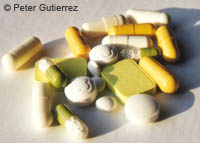Scientists develop new antibiotic
A team from pharmaceutical giant Merck, Sharp and Dohme has developed an entirely new type of antibiotic, using a novel pathway for dealing with bacterial infections. The first results on the effectiveness of the new antibiotic, known as Platensimycin, are published in the journal Nature, and show that it is effective against 'gram-positive' bacteria, including superbugs such as MRSA, in mice, and importantly - without toxicity. This breakthrough represents the first in what researchers hope will be an entirely new series of antibiotics. In 1928, Alexander Fleming discovered that the Penicillium notatum fungus killed some samples of his Staphylococcus bacteria while he was on holiday. While others had previously noticed this effect, it took Fleming's drive and foresight to turn this chance observation into a life-saving drug. It was not until 1942 that the first patient was treated with the active ingredient, Penicillin, but this event pushed medical advancement and ambition into a higher sphere. The first antibiotics won Fleming, along with Howard Walter Florey and Ernst Boris Chain who developed methods to mass-produce the drug, the Nobel Prize for medicine in 1945. Unequivocally, antibiotics revolutionised medicine. Antibiotics have saved an incalculable number of lives - certainly running to hundreds of millions of people. Lethal infections could suddenly be cured, and rapidly. Patients would show improvements within hours of the first dose, leading many to label antibiotics as 'miracle' drugs. Unfortunately, the efficacy of the early antibiotics, almost all of which were discovered in the 1940s and 1950s, is the principal reason for their fall from grace. Doctors over-prescribed the miracle tablets, and patients would feel better quickly, but crucially, often not complete the course. This could enable the bacteria to return in a more virulent or even drug-resistant form. Today, many diseases, previously treatable with antibiotics, are drug resistant, and the term is widespread. 'It is not just drug resistance, but multi drug resistance - these superbugs are very hard to treat,' explained Sheo Singh to CORDIS News. Along with lead author Jun Wang, he made the initial discovery, and led the microbiological and biochemical characterisation and natural products chemistry research. Platensimycin is only the third new antibiotic in 40 years. Dr Singh was responsible for isolating the new compound. 'The basic issue is resistance to existing types of antibiotic. This is a need. We have not developed many since 1960, and most of those are simply modified antibiotics. 'We focused on target areas. Several years ago we realised that if we continued to investigate the traditional target areas, we would find nothing,' he said. The team developed a novel approach to finding antibiotic targets. Traditional antibiotics, such as penicillin, work by blocking the bacteria's ability to build a cell wall, DNA and proteins. This kills the bacteria. However, because most antibiotics target these same pathways, this could in fact have accelerated the development of bacterial resistance. Steve Soisson coordinated the X-ray crystallographic analysis and direct binding assay development for the team, identifying specific pathways that the new compound acts through. He explained how the team developed a sensitive bacterium which would react strongly to antibiotic-like effects. 'We developed an elaborate screen by sensitised Staphylococcus bacteria. This was the enabling technology - the level of sensitivity was a critical part.' Sheo Singh again: 'We designed a bacterium to be sensitive to specific antibiotic effects, then screened for product extracts. These extracts came from soil samples, rubbish - we used more than 250,000 extracts looking for 'hits'. This is target-based wholescale screening. Without that the compounds would not be effective. But we needed two criteria to be met: a target-based discovery and the killing of the bacteria,' he said. While Alexander Fleming discovered Penicillin through luck, the team had to make their own luck, by testing their huge number of novel and candidate compounds until serendipity, or rather guided serendipity, produced a hit. Happily, the first hit has arrived - from a soil sample sourced in South Africa. The winning compound derived from another bacterium, Streptomyces platensis, which gives the new antibiotic its name. Not only is the compound novel, but so is its action. Platensimycin is a 'FabF inhibitor', blocking the bacteria's production of long-chain fatty acids. These fatty acids are essential for bacteria to build membranes and surfaces. While a select few drugs have been found that target this pathway, none have shown such a powerful antibiotic effect. Lead author Jun Wang told CORDIS news: 'This compound will help find new drugs on this pathway - this is a new paradigm. We have identified other targets, for example the cell wall, RNA protein synthesis - and we need to target those, too.' In fact, the team has significantly widened the scope for further breakthroughs. 'I am expecting more hits, both inside and outside Merck, to help the whole field,' said Dr Singh. The team is acutely aware of the need for new antibiotics, and Platensimycin has arrived in good time. 'The motivating factor [for this research] is current medical need - there is the potential for a global health crisis in the future, through a gradual erosion of the effectiveness of antibiotics. One day it will reach a critical stage. MRSA is already rising at a frightening rate,' said Dr Soisson. While there will be much excitement in the medical world over this breakthrough, one should remember that so far the pathways have only been tested on mice. The team was keen to remind CORDIS News that any talk of when products could be available remains 'highly speculative'. Meanwhile, the team is concentrating its efforts on their continued assessment of Platensimycin, and the search for further new antibiotics.
Countries
United States



